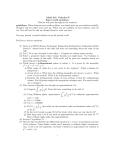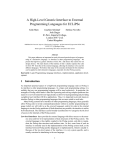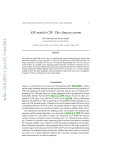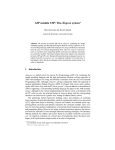Download 1 Introduction
Transcript
Two Problems - Two Solutions: One System ECLiPSe
Mark Wallace and Andre Veron
April 1993
1
Introduction
The constraint logic programming system ECLi PSe [4] is the successor to the
CHIP system [1]. Computation in ECLi PSe alternates between two modes:
constraint handling and host program execution. The host programming language is (an extended) Prolog, which handles search, and interaction with the
programming environment. The control for host program execution mode is the
usual Prolog control. The constraint handling mode has a quite dierent form
of control, which generalises data-driven computation. During constraint handling all possible information is extracted from the constraints. When there is
no more information to be extracted, the system returns to host program execution, which continues until another constraint is posted and constraint handling
restarts.
In the next section we show the advantage of combining Prolog programming
with constraints handling for a shift planning application. In the third section
we indicate how to control the constraint handling itself, and the application of
such control for optimising job-shop scheduling programs.
Shift Planning Application The problem is to decide the best shift rota to
make optimal use of a resource which is only available for a restricted time each
day. Clearly there is a limit on the weekly hours for each shift worker, and there
are other application-specic constraints. The problem is to choose start times
and end times for the shifts throughout the week.
The diculty lies in the cost function, since the hourly pay varies with the
time of day and day of the week. It quickly emerged that the best approach is
to divide the week into half hour periods, and associate nite domains with the
start and end times of the shifts. Unfortunately the constraints do not prune
the search space suciently to allow the optimum to be found in a practical
time. The reason is that the problem exhibits a huge number of symmetries
This paper appears in the Proceedings of the IEE Colloquium on Advanced Software
Technologies for Scheduling, London, April 1993
1
(based on extending one shift by a period of time, and reducing another by the
same period).
A solution was nally reached using an approach based on [3]. The approach
is an extension of backchecking, and relies on the concept of a nogood environment in the ATMS. We now show how nogoods were programmed in ECLi PSe
for this application.
The search routine is an essential component of most CLP programs, and in
the shift planning application it appears as a labelling procedure. This procedure, which non-deterministically assigns values to the problem variables, has
the form
label(Vars) :- Vars=[].
label(Vars) :- Vars=[V|Rest],
chooseval(V),
label(Rest). % Recursive call to label routine
Suppose the procedure chooseval which assigns a value to a variable makes
some bad choices, and at some point all attempts to label the remaining variables
fail. If V 1 = V al1; :::; V n = V aln are the bad choices already made when
backtracking occurs, the system has proved that there is no solution with these
values for these variables. However there is little use in recording this deduction,
since the system will never try the same partial labelling again.
However taking the problem constraints into account, we can draw a more
general conclusion about the cause of failure. As a trivial example, suppose
the problem has just one constraint, that the sum of all the variable values
must be greater than some given constant (i.e. V 1 + V 2 + ::: + V m > Const,
where m is the number of problem variables). Now when backtracking occurs
as outlined above, we can draw a much more useful conclusion than just saying
V 1 = V al1; :::; Vn = V aln is no good. We can conclude that, whatever values
are chosen for V 1; :::; V n, if V 1 + V 2 + ::: + V n =< V al1 + V al2 + ::: + V aln
then this partial labelling will still be no good!
ECRC, Arabella Strasse 17, 8000 Munich 81, Germany
For the shift planning problem we introduced just such a measure. If a
partial assignment of start and end times to shifts leads to a failure, the program
calculates the cost Cn of the partial assignment, and the period of time Un
during which the resource is unused. If any other partial assignment leads to a
cost C >= Cn and unused time U =< Un, then this will lead either to a failure
or to a solution with greater cost than one already found.
The extension of the labelling routine to check for nogood is simple in
ECLi PSe . First extra parameters are introduced to record the cost and unused times for the current partial labelling. Then an extra clause is added to
check if the current partial assignment is no good. If it is no good, the subgoals
2
!,fail cause the current labelling goal to fail too.
to update the nogoods when backtracking occurs:
Finally a last clause is added
label(Vars,Cost,Unused) :- Vars=[]. % Unchanged
label(Vars,Cost,Unused) :recorded(nogood,[Cn,Un]),
% Find a(nother) nogood
Cost >= Cn, Unused =< Un,
% Test it
!, fail.
% Fail the labelling call
label(Vars,Cost,Unused) :- Vars=[V|Rest],
chooseval(V),
calc(NCost,NUnused,Cost,Unused,V), % Calc new cost and unused
label(Rest,NCost,NUnused).
% Use new cost and unused
label(Vars,Cost,Unused) :record(nogood,[Cost,Unused]), % Record another nogood
fail.
% Fail the labelling clause
Not only is the extension quite trivial in ECLi PSe , it also leaves the usual
constraint handling unaected. The resulting program therefore uses reactive
constraints to prune the search tree and nogoods as an additional mechanism.
Experiments showed that neither feature alone enabled a solution to be found it was the combination which made the problem tractable to ECLi PSe .
2
Constraints Handling for Job Shop Scheduling
In this section we concentrate on constraint handling. We distinguish two varieties of constraints: primitive constraints and reactive constraints. Primitive
constraints are added, during computation, to a global constraint store. Thus
primitive constraints are a generalised form of data. They allow not only a value
to be associated with a variable (as in traditional data stores) but any primitive
constraint to be imposed on any variable or variables. To ensure that the system
does not hold contradictory constraints in its store, such as X > Y and Y > X,
ECLi PSe provides a global procedure which to decide the consistency of each
new primitive constraint with the current store. The CLP Scheme [2] describes
the integration of primitive constraints in logic programming.
Dierent classes of primitive constraints admit dierent decision procedures.
For example the decision procedure for linear equations and inequations over
the rationals can be used to detect the inconsistency of the above constraints.
However such a decision procedure can be computationally expensive when the
number of primitive constraints in the store grows.
We now introduce reactive constraints. Reactive constraints are agents
with a behaviour which may be either program-dened or built into ECLi PSe .
Shortly, the behaviour is as follows: the agent does nothing until a certain condition (or guard) is entailed by the current constraint store; then it transforms
3
itself into a new set of agents, possibly adding new primitive constraints to the
store. Often a reactive constraint is dened by a (nite) number of alternative possible behaviours. A behaviour is then chosen non-deterministically at
runtime.
A very simple example of a reactive constraint which occurs in every scheduling problem is the constraint that two tasks cannot run on a machine at the
same time. If S1 and D1 are the start time and duration of one task, and S2
and D2 are those for another, the reactive constraint can be dened as follows:
nonOverlap(S1,D1,S2,D2) ==> S1+D1>S2 | S1 >= S2+D2
nonOverlap(S1,D1,S2,D2) ==> S2+D2>S1 | S2 >= S1+D1
This constraint has two alternative behaviours, one specied by each line in
the denition. Informally this denition makes sure that the two tasks do not
overlap by adding, as soon as one task A cannot be completed before the other
B starts, a constraint that A must start after B is completed.
The rst line says that if the current constraint store entails the guard
S1+D1>S2 then the reactive constraint nonOverlap(S1,D1,S2,D2) transforms
itself into the empty set of constraints (i.e. it disappears), and a new primitive
constraint S1 S2 + D2 is added to the constraint store. The second line
denes a symmetric behaviour. The nonOverlap constraint can be used for
solving small scheduling problems, but it generates a large number of primitive
constraints and the linear solver mentioned above quickly becomes too inecient
for tackling non-toy scheduling problems.
An advantage of reactive constraints is that their behaviour is program dened. Thus we can dene a reactive behaviour for constraints that is weaker,
and computationally less costly, than solving. A simple example is the treatment of non-linear equations by delaying them until they are linear. A more
radical example is the treatment of linear inequations and disequations by nite domain propagation as in cc(FD) [5]. This is (usually) much cheaper than
treating them as primitive constraints and testing them for global satisability.
Propagation is simply a reactive constraint behaviour.
Using this approach we can replace the primitive constraints S1 >= S2+D2
and S2 >= S1+D1 in the denition of nonOverlap with reactive constraints
which perform nite domain propagation. The resulting scheduling program
is ecient enough to solve small, but non-toy, problems.
For larger more complex scheduling problems it is necessary to perform more
global reasoning, on all the tasks which run on a single machine, rather than
just pairs of such tasks. Such global reasoning is also straightforward using
reactive constraints, though the form of the guards required is more general.
For example we need to extract the earliest possible start time and the latest
possible end time for a set of tasks, and the sum of their durations. ECLi PSe
provides facilities for accessing this information, and for tailoring constraint
propagation to the application at hand.
4
Explicit control of constraint behaviour has been used to obtain a guaranteed
optimal solution the 10X10 job shop problem. More generally, the integration
of primitive constraint solving, reactive constraint behaviours and host program
control provide a complete armoury for tackling practical job shop scheduling
problems.
3
Conclusion
With ECLi PSe we have introduced a second generation constraint logic programming language in which the advantages of CHIPs built-in constraint handling have been retained while \opening" the box and enabling users to construct new reactive constraints. Moreover the open architecture of ECLi PSe
has enabled us to add new solvers and test new features, such as intelligent
backtracking, without modifying the system itself. Ongoing experimentation
with practical problems continues to reveal the eciency and expressive power
of ECLi PSe .
References
[1] M. Dincbas, P. Van Hentenryck, H. Simonis, A. Aggoun, T. Graf, and
F. Berthier. The constraint logic programming language chip. In Proceed-
ings of the International Conference on Fifth Generation Computer Systems
(FGCS'88), pages 693{702, Tokyo, Japan, December 1988.
[2] J. Jaar and J.-L. Lassez. Constraint logic programming. In Proceedings of
the Fourteenth ACM Symposium on Principles of Programming Languages
(POPL'87), Munich, FRG, January 1987.
[3] F. Maruyama, Y. Minoda, Sawada S., and Y. Takizawa. Constraint satisfaction and optimisation using nogood justications. In Proc. 2nd Pacic
Rim Conf. on AI, 1992.
[4] M. Meier, J. Schimpf, and et.al. ECLi PSe , ecrc common logic programming
system, user manual. Technical Report TTI/3/93, ECRC, 1993.
[5] P. Van Hentenryck, H. Simonis, and M. Dincbas. Constraint satisfaction
using constraint logic programming. Articial Intelligence, 58, 1992.
5


























